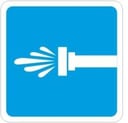A good and periodic diaphragm pump maintenance is the best investment to extend the life of an agricultural sprayer.
Maintenance aims to take care of your pump's efficiency, improving its operation and life.
By reducing faults, you can also reduce operating costs, which are increasingly higher in the event of a pump failure. Operations such as periodic diaphragm replacement are investments in the life of your sprayer and avoid higher and unexpected costs.
Planned diaphragm pump maintenance is easy and profitable in the long term.
Without maintenance, your pump may have problems such as the break of valves and diaphragms, supporting feet, or irreparable damage such as seizure of the mechanical components.
If you experience these problems, it means that maintenance was not performed correctly or regularly.
In this article you will find the routine maintenance procedures, these are elementary and fast operations but if carried out continuously they greatly improve the performance of your diaphragm pump, thus reducing the operating costs of your sprayer.
7 EASY PROCEDURES THAT EXTEND THE LIFE OF YOUR DIAPHRAGM PUMP
1. Tightening

For a correct tightening, it is necessary:
- to check that the pump is firmly secured to the sprayer’s chassis
- to check that the fittings are connected to the pipes of the circuit without any leakage of liquid or air suction
2. Flush

After each use, flush the inside of the pump thoroughly with clean water. Most chemical attacks occur when chemicals are allowed to settle inside the pump.
Special attention should be paid to rinsing the filters, as obstructions can cause serious damage.
3. Oil level

Oil has a double purpose:
- lubricate the mechanical parts
- act as hydraulic support for the diaphragms in the delivery phase.
Therefore, always keep the level indicated in the compensator and, if necessary, top up to reach the appropriate level.
4. Pressure accumulator (or pulsation dampener)

The pressure accumulator is designed to reduce pulsations.
Every 50 hours of work, the air charge inside must be checked and, if necessary, the pressure must be reset by means of a pump.
To set the pressure correctly, refer to the specific literature for the model of your pump.
5. Routine maintenance

Every 300 hours of operation, you must replace the diaphragms and check the condition of the valves, in particular springs, plates and rings. Also, check if it is necessary to change the oil.
These checks must also be carried out at the end of the season or after 300 hours of operation (whichever comes first).
6. Winter storage

Every 300 hours of operation, you must replace the diaphragms and check the condition of the valves, in particular springs, plates and rings. Also, check if it is necessary to change the oil.
These checks must also be carried out at the end of the season or after 300 hours of operation (whichever comes first).
7. Power take-off

Always check that the cardan shaft is correctly sized for the type of machine and pump and ensure the PTO is always adequately lubricated.
To learn more, read also: DIAPHRAGM PUMP TROUBLESHOOTING: HOW TO FIX MOST COMMON PROBLEMS
or download the complete Comet guide:












